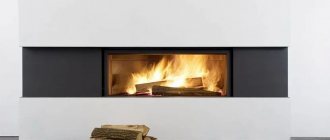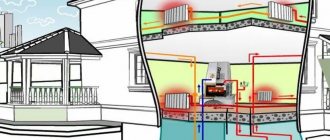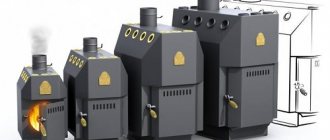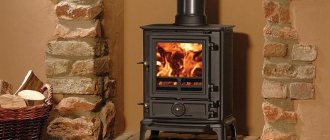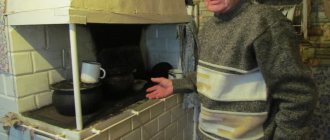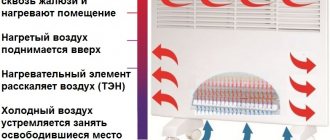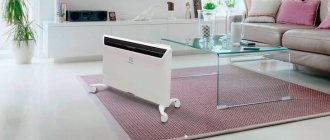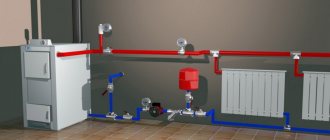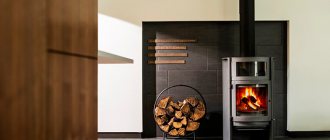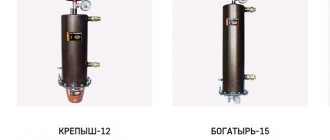Firewood is one of the most affordable types of fuel, which perfectly copes with its tasks - providing comfortable warmth and creating coziness in the room. It is not without reason that many continue to use wood stoves for heating country houses and cottages. This is a beneficial solution for locations with seasonal residence, especially where there is no centralized gas supply. The best wood stoves are economical in fuel consumption, easy to use and have an attractive appearance - even in a small room they do not look bulky. The Garden Assistant online store provides an overview of wood-burning stoves and gives tips on choosing models for your household needs.
Thermal power
Let's start considering the parameters for choosing heating equipment by assessing the thermal power. In an effort to save money, some buyers choose a small, cheap stove, which in practice cannot cope with heating tasks. Its power is not enough to provide heat to a large room. At the same time, a stove that is too large can also create a number of difficulties:
- dry air in the room;
- too high uncomfortable temperature;
- high fuel consumption;
- formation of a large amount of soot and soot.
Important! When assessing the power of the model you like, take into account the dimensions of the room and the likely heat loss - how windy the windows are, whether the attic is insulated, whether the walls freeze.
To calculate power you can use a simple formula:
- Multiply the length of the room with the width and height.
- Divide the resulting number by 14.
This way you will get an indicator in kilowatts that you can use as a guide when purchasing. Keep in mind that some manufacturers indicate its maximum power in the passport for the device, so take a model with a small margin so that its capabilities are enough to heat your home or cottage.
“TOP-model-140” with cast iron door
Characteristics:
- thermal power – 14 kW;
- maximum area of heated premises – 140 m3;
- door type – cast iron, with glass panel;
- chimney diameter – 115 mm;
- weight of the structure – 69 kg.
Price – from 16,260 ₽.
Product link: https://sadpom.ru/products/pech-otopitelnaya-top-model-140-s-chugunnoj-dverkoj/
The rating of wood stoves opens with the TOP model 140, designed for convection heating of buildings. This is a medium-power device that does an excellent job of heating large spaces with a volume of 70 to 140 m3. A rapid increase in temperature is achieved due to hot air flows that heat up inside the oven and exit through special holes in its upper part. The unit can be used in conjunction with a mounted heat sink, which will allow heating adjacent rooms.
Advantages of the model:
- efficient three-turn firebox;
- the ability to heat food on the upper platform;
- increased service life due to a flame arrester made of stainless steel;
- compact dimensions with average power ratings.
Flaws:
- dust entering the air along with air currents;
- Coal and wet wood should not be used for heating.
Back to Contents
What to choose from: types of stove equipment for a summer residence
Information about the efficiency and features of popular stoves for summer cottages will help you decide on the choice of heating equipment. It is installed once and for many years, so the choice is approached thoughtfully and thoroughly.
The choice of stove must be approached carefully
Russian
A real Russian stove is a large and heavy structure that requires a spacious room. Today, the original Russian model has been modernized to suit modern conditions and has smaller geometric parameters, but still efficiently heats large areas.
Russian stoves are equipped with stoves, ovens and stove benches. The efficiency of brick structures of this model is high, at least 75%. The peculiarity of the stove lies in its design, consisting of a system of channels and a chimney. Therefore, it heats up quickly, accumulates heat and gradually releases it, thereby maintaining a stable temperature in the room.
The original Russian stove model has been modernized to suit modern conditions.
Dutch
The Dutch oven is one of the most efficient and therefore popular country stoves. Its design has its own characteristics:
- a winding system of channels located one above the other;
- lack of grate;
- variety of furnace body shapes: round, semicircular, rectangular, with protrusions;
- The walls are laid using 1 brick, which results in low weight.
The Dutch oven quickly warms up the room and retains heat for a long time. It features economical fuel consumption. Can be equipped with a stove and a bench.
The oven can be equipped with a cooking plate
Brick Swede
The Swede is an impressive and cozy stove, the efficiency of which is at least 60%. The structure is lightweight and therefore does not require a large amount of materials for construction. The Swede is one of the best stoves for heating country houses and residential buildings. Ideal for small buildings, suitable for year-round heating.
Long burning mode
The best heating stoves are designed in such a way as to retain heat for as long as possible and prevent rapid combustion of fuel. When purchasing, make a choice in favor of pyrolysis devices with a long-burning option - they are equipped with an additional firebox for burning the gas emitted by wood. This design slows down the process of fuel burnout, which allows you to maintain a comfortable room temperature for up to 8 hours on one stack of firewood. Such modifications differ from conventional furnaces in the metered supply of oxygen in the upper part of the body.
A stove with pyrolysis mode will be an excellent solution for heating at night. It is enough to prepare a pile of firewood in the evening to keep the house warm until the morning.
Long-burning furnace "Matrix-200"
Specifications:
- maximum power – 20 kW;
- volume of heated room – 200 m3;
- door type – steel with heat-resistant glass;
- chimney diameter – 115 mm;
- net weight – 74 kg.
Cost – from 18,690 ₽.
Link to the product:
The Matrix wood stove perfectly combines modern design and time-tested technical solutions. The model supports a long burning mode for up to 8 hours due to a multi-turn firebox and dosed air supply for combustion of residual gases. The device is suitable for heating country houses, large workshops, garages, outbuildings, and the design allows the chimney to be routed in a convenient direction - up or back.
Pros:
- recessed design – saves space and expands installation possibilities;
- convector casing – responsible for fast, uniform heating;
- presence of a panel for heating food.
Flaws:
- requires a lot of draft to effectively remove combustion products;
- increased soot formation.
Back to Contents
comparison table
The following table will help make it easier to choose a suitable long-burning stove for your dacha. It presents the main characteristics and average cost of popular models.
| Model | power, kWt | Burning time, h | Dimensions, cm | Weight, kg | Average price, rub. |
| Klondike NV-100 | 6.2 | 8 | 43.60x64x60.50 | 52 | 16 938 |
| Ermak Ermak-Thermo 100 | 6 | 12 | 35x60x67 | 45 | 17 500 |
| Vesuvius AOGT 00 | 6 | 12 | 42x63x60 | 50 | 15 885 |
| NMK Sibir BV-100 | 4 | n/a | 44x69x58 | 45 | 17 084 |
| Teplodar Matrix-100 | 10 | 8 | 32×59.50×60.50 | 52 | 21 970 |
| TMF Fire-battery 7 anthracite | 10 | n/a | 37x76x68 | 51 | 23 021 |
| Birch Bulyk 150 | 8 | 12 | 50x73x60 | 55 | 21 494 |
Availability of a hob
If a stove is purchased for a suburban area, the presence of a cooking panel will be a huge plus. A device of this type allows you to solve three problems at once - create a comfortable microclimate in the room, provide a lot of heat for preparing simple dishes and maintain the temperature of the prepared food for a long time.
Important! Depending on the design of the upper part of the boiler, the user can cook food over an open flame or on a special surface that imitates a hob.
Ovens with a hob are created using a special design that does not allow heat to dissipate, but concentrates it near the surface of the stove. Another important point is that the furnace casing itself should not get too hot so as not to cause burns. To adjust the heating power, the design includes metal rings - by removing them, you can change the diameter of the hole for supplying the flame, thereby decreasing or increasing the temperature.
Most often, manufacturers use cast iron and steel alloys to make hobs. Cast iron stoves are heavy, but they last a very long time. If you are looking for lighter, more compact designs, choose units made from steel.
“Pechurka +” with cauldron function
Characteristics:
- maximum power – 5 kW;
- room dimensions – 50 m3;
- type of construction – floor;
- hob – cast iron with cauldron rings;
- door – steel;
- connection to the chimney – rear;
- product weight – 29 kg.
The cost of equipment is from 7,860 ₽.
Link to the product:
The rating of wood-burning stoves for summer cottages includes this compact, ergonomic model, which is ideal for small spaces - garages, outbuildings, garden houses. The body, made of steel, is equipped with a cast iron hob with rings in the upper part. The stove easily turns into an open hearth for installing a cauldron - to do this, just remove the removable rings. “Pechurka” will help you easily prepare your favorite dish, providing food for even a large company.
Advantages:
- combination of stove and hearth for a cauldron;
- protects against infrared radiation thanks to a decorative convector casing;
- takes up little space;
- Convenient to transport.
Disadvantages of the model:
- not suitable for large rooms;
- only one connection option to the chimney.
Heating and cooking stove "GreyVari 100"
Specifications:
- thermal power – 10 kW;
- maximum volume of heated area – 100 m3;
- hob – yes;
- burner diameter – 154 mm;
- type of connection to the chimney – top;
- structure weight – 43 kg.
Price – from 9,610 ₽.
Product link: https://sadpom.ru/products/pech-otopitelno-varochnaya-grejvari-100/
The installation is designed specifically for air heating of premises whose total volume does not exceed 100 cubic meters. At the top of the oven there is a cooking surface on which you can simultaneously place several containers for cooking. The back wall is reliably protected from overheating by an aerodynamic nozzle, and the directed flame flow allows you to create the optimal temperature for cooking. The complex shape of the firebox increases the heating area, and combustion efficiency increases due to the secondary supply of air to the afterburning zone.
Pros:
- high efficiency values;
- there is a panel for cooking;
- warms up quickly;
- Keeps warm for a long time.
Flaws:
- low power;
- The efficiency of work directly depends on the quality of the installation.
Back to Contents
Recommendations for choosing stoves
Regardless of what the heat source is, it must provide adequate heating of all rooms of the house. Whether a garden stove is capable of this will be determined by its characteristics:
- power;
- heat transfer;
- Efficiency (coefficient of efficiency).
Power is an indicator of the properties and efficiency of the furnace, but you need to understand that in different modes of operation of the heat source, it will show different power. And yet this is the main criterion that you need to focus on when choosing heating equipment.
On average, heating 25 m3 of heated space requires 1 kW of rated power. They also take into account the condition of the house and its ability to retain heat. In this regard, the average equipment efficiency indicator is adjusted in one direction or another. Taking into account the condition of the house, 1 kW of heating equipment power is enough to heat:
- 14–15 m3 of a building without thermal insulation, located in a cold climate zone;
- 25–27 m3 in an insulated house in a cold climate region;
- 33–35 m3 in a thermally insulated building in a warm climate zone.
The next important indicator of equipment efficiency is efficiency, the value of which is calculated using the formula: ab = efficiency
Where “a” is the amount of thermal energy that is obtained during complete combustion of fuel;
“b” is the amount of thermal energy actually transferred by the stove to heat the room.
The characteristics of furnaces directly depend on their geometric parameters and material of manufacture. Therefore, large-sized heating devices are not always more effective than small ones, since the latter can be made of material with higher heat transfer.
Every year, the use of natural energy sources and the use of waste for heating a home becomes more and more relevant. For example, you can independently build a plant for producing biogas. More details about this in our material: .
Furnace design
Modern manufacturers are gradually abandoning bulky structures in favor of compact, energy-efficient models with a stylish design. Since wood stoves are most often used to heat one or two adjacent rooms, it makes no sense for buyers to purchase massive units that will only clutter the room.
If you don’t know which heating stove is best to choose for your living space, take a look at modern models stylized as a wood-burning fireplace, with transparent doors through which you can admire the open fire. Units with forged elements that fit perfectly into a classic country interior are popular.
Important! To light a fire in the fireplace faster, store the wood in a dry place or place it in a special firewood box to dry in advance.
Wood burning fireplace "Tango"
Characteristics:
- heated room volume – 80 m3;
- door material – heat-resistant glass with a visible diagonal of 500 mm;
- chimney diameter – 150 mm;
- smoke exhaust type – rear;
- device weight – 91 kg.
The cost of the model is from 27,810 ₽.
Link to the product:
The rating of heating stoves is completed by an elegant wood-burning fireplace with a glass door. Inserts made of stainless mirror steel create interesting highlights, captivating with the beauty of the flame and giving the design visual lightness. The large diagonal of the glass door allows you to admire the flames and create a cozy atmosphere in the house. The design includes a compartment for storing and drying firewood and a firebox protection system - vermiculite slabs.
Advantages:
- spectacular appearance;
- does not require a foundation for installation;
- compact design;
- effectively copes with heating tasks;
- There is a built-in stove for heating and cooking.
Flaws:
- relatively high price;
- not suitable for heating large rooms.
Back to Contents
Wood stove for heating a private house: analyze and choose
Wood stoves for heating a private home are no less (and in some regions even more) in demand than at the beginning of the last century. Most often, the “fault” of such popularity is the availability of fuel and the attractive cost of the heat generator itself. In addition, we should not forget about “forced popularity”, when connecting to a gas pipe is impossible, and storing other types of fuel (coal, diesel fuel, gas in cylinders) is quite troublesome.
The Russian market of climate control equipment offers a variety of models of modern wood-burning stoves for heating a home, cottage or small technical premises. The types, design features and selection criteria for this equipment will be discussed in this publication.
What does the domestic market offer?
Despite the abundance of types and varieties of wood-burning heating devices, they all have a common principle of operation: obtaining heat from the combustion of wood or wood waste. Depending on the design features of the device, thermal energy is used to heat the air or the built-in “water jacket” for the radiator heating system. The second option is most often used for heating large country houses or industrial premises, the first is for heating small private and country houses, garages, etc. Almost every line of these products has models with a built-in hob. If desired, you can also find a wood-burning stove with a boiler for heating the house and creating hot water supply in it.
This equipment differs:
- Heat transfer power, which must be selected based on the volume of the heated room.
- Body shape. As a rule, most manufacturers produce stoves of a traditional rectangular or cylinder shape. For small rooms, our compatriots prefer to purchase corner heat generators.
- Case material. The specificity of the operation of these heating devices is such that steel or cast iron is used for the production of wood-burning stoves. You can build a fireplace stove to heat a house made of brick or natural stone, but this decision is associated with many difficulties, among which the main ones are time costs and serious financial investments in the material and the work of a stove specialist.
There is another important difference between wood-burning stoves presented on the domestic market - this is the design of the boiler unit, which affects the principle of fuel combustion, power, efficiency and other characteristics.
Single chamber, direct combustion
Such heating devices have the simplest design of a combustion chamber with a grate at the bottom, under which there is an ash pan. These stoves are (in common parlance) called “stoves”. The operating principle of these devices is as follows: when wood burns, the body heats up, which becomes a source of infrared radiation. Single-chamber furnaces do not require automation or additional air pressure.
Advantages: simplicity of design, energy independence, affordable cost.
Disadvantages: High maintenance requirements. Low efficiency (35-45%).
Important! Since the main source of heat in single-chamber furnaces is the body, there is a high fire hazard and the likelihood of injury (burns) due to careless operation.
Convection
Heating boilers of this design, as in the first version, have one combustion chamber. To increase the efficiency and eliminate the main problems, manufacturers equip the equipment with air channels that pass between the firebox and the casing of the device. In cheaper models, the channels are made in the form of gratings in the upper and lower parts of the boiler installation; in more expensive ones, this is a whole set of pipe sections recessed into the combustion chamber.
Heating of the room occurs due to convection: the air in the pipes heats up and leaves the upper pipes. Its place in the air channels is taken by colder air, which (according to the laws of physics) is located in the lower part of the heated room.
Convection stoves for heating a house using wood heat the room quickly enough, while their surface remains practically cold.
Tip: If you connect air ducts to the top of some air ducts, then such a stove can even heat several adjacent rooms in the house.
Hydrolytic
This type of heat generator uses the principle of high-temperature combustion of organic matter in an oxygen-depleted environment. In this case, the furnace receives thermal energy from two sources: during the combustion of fuel and pyrolysis (hydrolysis) gas, which is discharged into a separate chamber, where it is burned out. Air is supplied to the afterburning chamber using an inflatable fan. This type of heating equipment is usually equipped with automation that controls all fuel combustion processes.
This design has a number of advantages:
- High efficiency (up to 90%)
- Environmentally friendly.
But the main advantage of hydrolysis boilers is the reduced frequency of maintenance due to the increased burning time of wood and a tiny amount of dry residue (ash).
Disadvantages: Possible formation of condensate (at insufficient temperature of exhaust gases), high cost, requirements for fuel moisture, volatility.
Heat generators powered by wood waste
All woodworking waste, which is used as fuel for these heat generators, is compressed in the form of small granules, which allows them to be burned using a special burner. Fuel is supplied to the burner automatically, using a screw mechanism or a pneumatic pump.
Such wood-burning stoves are rarely used for heating homes due to their rather large dimensions. The design of the heat generator is single-chamber. The air in the room is heated by direct heat transfer from the surface of the furnace or by heating the heat exchanger with coolant circulating through the heating system.
The main advantage of this type of boiler equipment is long-term autonomous operation without human intervention.
Disadvantages: Volatility dependence, the presence of a separate room for storing fuel, high cost of equipment.
Where to install a wood heating boiler?
When purchasing a wood stove to heat your home, you should understand that the operation of such equipment involves open fire and the release of toxic combustion products. That is why the main requirement for the installation of heat generators is fire safety, the presence of a functioning ventilation system and chimney in the heated room.
- In a wooden house, the distance from the wall to the boiler installation must be at least 1 m. When finishing the walls with a fire-resistant plaster mixture or installing a heat-reflecting screen, the distance from the boiler to the wall can be reduced to 0.8 m.
- As a base, it is necessary to use a fireproof stand that protrudes beyond the perimeter of the heat generator by at least 300 mm.
And as a conclusion: Proper installation of a wood-burning stove requires certain knowledge and experience. We strongly recommend that all procedures related to the installation of heating equipment and the organization of a smoke removal system be entrusted to professionals.
ventilationpro.ru
Additional selection criteria
To avoid making a mistake when choosing a wood stove model, evaluate the following factors:
- how much space are you willing to allocate for installing a heating system;
- how often will you use the unit;
- Do you plan to cook on the stove?
- where and how you can install the chimney.
Additional options also include:
- Body and firebox material. The best reviews are received by models made of high-alloy heat-resistant steel or cast iron. They are durable, hold heat well and do not burn out.
- Economical. Make a choice in favor of devices with high efficiency rates, long-burning modes and sealed doors that prevent heat loss.
- Dimensions. Selected in accordance with the room in which the stove is planned to be installed. The stove should not take up much space and create discomfort for people in the building. This parameter is especially important in small country houses, where every centimeter counts.
- Safety. A good stove should provide a lot of heat to the room, but at the same time protect the body from overheating and the user from accidental burns. The permissible heating temperature of the housing surface should not exceed 90-95 °C.
- Volume of the combustion chamber. A large firebox can accommodate a large amount of firewood at once, which frees the user from the need to constantly load fuel. In addition, a small chamber in practice turns out to be inconvenient when working with large logs.
- Connection to the chimney. The best choice would be a universal option for removing combustion products, when the pipe can be connected in several ways - from behind, from above, from the side. If there is no such choice, evaluate in advance the features of the chimney system in your home so that the selected stove can be easily connected to it.
Choosing a wood-burning stove will not be a difficult task if you think through all the installation nuances in advance and assess your own needs for certain functions.
The largest, expensive model will not always be a good solution, especially if the room is small or rarely used. Select power and design so that the climate is comfortable with low fuel consumption. Return to list of articles
Main characteristics and parameters of a high efficiency furnace
Let's figure out what parameters affect the efficiency of the furnace:
- the mandatory presence of the ability to connect water heating to both one and two or more circuits;
- a powerful water heater for options running on electrical energy, or a good firebox for solid fuel stoves. At the same time, keep in mind that solid fuel stoves are energy independent, that is, they operate regardless of the presence of an electrical network or gas pipeline on the site, and this point can be decisive when choosing. So, for example, if in a summer cottage there is an unstable power supply and the voltage in the network often sags, then choosing a volatile stove model in this case is irrational;
- fuel-burning stoves operate regardless of the presence of an electrical network or gas pipeline on the site;
- it is possible to control the combustion process and regulate it as necessary;
- the ability to use equipment for heating buildings with a sufficiently large area (for certain models or types of stoves);
- ease of maintenance;
- high efficiency.
All fuel costs can be dramatically reduced without even calculating the efficiency of the furnace: costs are reduced up to 10 times (!) when using a slow-burning catalytic furnace. It runs on any fuel, including cheap waste from agricultural products and wood processing - wood chips, sawdust, shavings. This will be especially beneficial for modern villages in environmentally friendly areas and various small enterprises where such types of fuel are obtained as a result of their production activities.
Slow burning stoves with high efficiency can be used not only for space heating, but also for cooking, drying fruits and berries, mushrooms, even lumber and small logs.
What modern stoves are best for heating a home?
Modern stoves for home heating are functional, powerful units that allow you to create economical autonomous heating systems in country houses. Modern technologies for stoves intended for heating a country house offer many options: stoves differ in design, the material from which they are made, the fuel they use, efficiency indicators, etc.
In addition, such stoves are environmentally friendly and do not harm the residents of the cottage. But everyone who has a country house, first of all, takes care that the materials and technologies used in the home do not cause harm to households and the environment.
In this article, let's take a closer look at what stoves for country houses are offered to us by modern manufacturers.
Types of modern stoves for heating a home
Modern stoves for heating a home, as noted above, are classified according to different indicators, but the main ones are the materials from which the stoves are made and fuel. Modern stoves for heating country houses use firewood, coal, natural gas, peat briquettes, etc. as fuel.
Depending on this, furnaces can be:
- gas;
- wood (coal).
But there are many more types depending on the material of manufacture.
Modern stoves are made of cast iron, lined with stone or brick (traditional stove options) and other materials. In addition, stoves come in different thermal conductivities. There are three types:
- low thermal conductivity;
- medium thermal conductivity furnaces;
- high thermal conductivity.
There are different types of stoves in terms of burning time. Long-burning stoves are used to heat the house. Therefore, we will not talk about other types this time. Modern long-burning furnaces can be equipped with a function for afterburning flue gases. They are also made from different materials, and such stoves can be heated with wood or coal. We propose to take a closer look at several types of such stoves and the conditions for their use for heating a country house.
Modern stoves for heating a cast iron house: long burning and afterburning function
Modern stoves for heating a house made of cast iron, classified as long-burning stoves, are often equipped by manufacturers with an additional function for afterburning flue gases. What are the features of this function and, in fact, the most modern cast iron stove for home heating?
The main feature that should be noted is the fairly high efficiency rate of stoves of this type. It reaches 70-90 percent.
Such a cast iron stove works as follows: with a sufficient amount of oxygen, the firewood burns very brightly in the firebox; when the oxygen burns out, it continues to smolder due to the high temperature. During the combustion of wood, so-called flue gases are formed, which are a mixture of hydrogen, carbon monoxide, methane and other components. Previously, these gases were a kind of waste; today they are also used for heating. Modern models have an afterburning zone, where a mixture of different components enters. There, this mixture burns, releasing a very large amount of heat and increasing the efficiency of the furnace.
The afterburning zone can be located either directly in the furnace firebox, or it can be a separate chamber that is installed above or below the firebox. In order for the flue gases to ignite, air is additionally supplied into the chamber, which mixes with the gases and promotes their combustion.
What are the advantages of such long-burning stoves? Almost waste-free, clean work. The firewood in the firebox burns completely, and the flue gases also burn out, giving additional heat to the house, while soot and tar are not deposited on the internal surfaces of the stove. And most importantly, combustion products enter the atmosphere in minimal, non-hazardous quantities.
Long-burning furnaces that have an afterburning function can be made not only from cast iron. Steel stoves are widely used, fireplaces with such functions, masonry stoves, etc. are installed. Note that most stoves of this type are classified as low-heat capacity units, which are usually used for domestic heating.
Long-burning cast iron stoves are available in different sizes: there are models designed to create autonomous heating systems, and there are small options that are suitable for heating individual rooms in a country house. Small stoves also have a good efficiency rate - in the range of 80-84 percent.
Such stoves are usually installed in houses where heating may be needed rarely and for a short time (for example, in a country house on a rainy and cold day). In country houses that are actively used in winter, such stoves can only be installed as an additional source of heat.
The dimensions of cast iron stoves affect their power. In general, manufacturers produce models with a power in the range of 3-17 kW, while stoves with minimal power can be installed in small rooms, and powerful stoves (15-17 kW) are suitable for heating a one-story cottage with an area of no more than 150 square meters.
In order for the stove to heat all the rooms in the house, it is necessary to equip a heat distribution system (heating system) and through it it will deliver heat to all rooms of the country house. For such a distribution system, special ventilation ducts and grilles can be used that allow warm air to pass through. Fans help distribute it throughout the house.
Cast iron stoves with an afterburning function are not an ideal solution for creating an autonomous heating system, since the air heated by the stove may cool down before it reaches all rooms of the house. Therefore, professionals recommend using a special heating stove made of cast iron.
All long-burning cast iron stoves use solid fuel, but not too high in calories. Firewood with a moisture content of 15-20 percent is suitable for these purposes, and rarely brown coal, as well as peat briquettes.
Heat transfer in such furnaces is carried out through thermal radiation and convection. The latter is organized using special channels into which air enters, then it is heated and exits into the room through the provided grilles.
Most modern cast iron stoves have doors made of heat-resistant glass. This feature allows you to observe the burning flame. Some models may also have hobs or niches for cooking, this makes them multifunctional units.
The main advantage of these stoves, in addition to being environmentally friendly, is the rapid heating of the room. They are able to heat the air in a small room in 30 minutes. This feature makes them more popular compared to traditional stoves, which must be pre-heated to heat the room. On the other hand, the surfaces of such ovens become very hot, so they must be handled with extreme caution.
Modern stoves for heating a house made of soapstone are classified as long-burning heat-accumulating units that have an afterburning function. These modern soapstone stoves are very effective for heating a country house. Their efficiency is 88-90 percent. Stoves made of this material have a large heat capacity and allow you to heat several rooms quickly and efficiently. For equipping an autonomous heating system in a country house, the use of such stoves is one of the best options.
The peculiarity of this type of stove is that they are able to accumulate heat and, over time, slowly and fairly evenly release it into the room. This became possible thanks to soapstone, which has a heat capacity 2.5-3 times higher than that of brick.
In addition, this feature, among other things, allows you not to worry about firewood. They can be added no more than 1-2 times a day.
Soapstone furnaces are very bulky and can weigh several centners, or even tons. Most often, such stoves have fireplace doors with heat-resistant glass (quartz), which does not smoke thanks to specially organized airflow.
Such stoves can be finished to suit any interior; the decoration can, for example, imitate a traditional Russian stove and more.
These stoves are heated with wood, brown coal, peat briquettes, etc. The combustion chamber of soapstone stoves withstands high temperatures. The peculiarity of this stove is that, if desired, it can be supplemented with electric heating elements, which will maintain the temperature in the country house even during the absence of the owners.
Soapstone stoves are safe from an environmental point of view: like cast iron stoves of this type, they do not emit combustion products into the atmosphere. In addition, the surfaces of the oven heat up to no more than 70 degrees. These units also maintain the air humidity in the room within 30-60 percent. Models are available that have ovens for cooking, so this modern oven will completely replace a conventional Russian oven. The disadvantages of this furnace include thermal inertia: the furnace takes a long time to heat up - up to two hours. In addition, it can be installed only after installing a special foundation for the furnace, and, of course, it is not recommended to install it on the second floor.
www.yourcottage.ru
Making an economical wood stove with your own hands
Of course, purchasing a ready-made long-burning heating unit is easier than making it yourself. But, as already mentioned, such installations are inexpensive.
If you want to make an economical wood-burning stove yourself, you can use an old gas cylinder, metal barrel, sheet steel and other available materials suitable for this purpose.
First of all, you need to prepare the basic materials that may be required:
- Metal drum with a capacity of approximately 200 liters without rust or other obvious damage. Its walls must be strong, made of cast iron or steel alloy.
- An old large capacity fire extinguisher that will make a good base for the unit.
- A section of thick-walled wide metal pipe.
- An old gas cylinder.
- Steel sheets with a thickness of at least 5 millimeters.
A boiler with a round base requires support legs, which can be made from:
- pieces of reinforcement;
- pieces of thin pipes;
- metal profile.
In addition, the home craftsman will need:
- Steel sheet having a thickness of 5 millimeters. You will have to cut circles out of it, the size of which coincides with the diameter of the metal barrel.
- Metal profile.
- Stove door - you can purchase it or make it yourself.
- Metal pipe with a cross section of 10 centimeters. Its length should exceed the diameter of the barrel by 15 centimeters.
- A chimney pipe is 5 meters long and has a cross-section of 15 centimeters.
